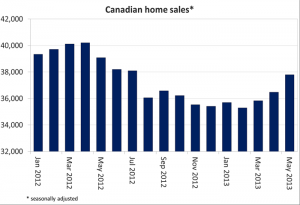
In the spring Canadians begin to go out more and search for new places to live because its much easier to move during the warmer spring and summer months.
Canadian real estate forecast rising housing market
Canadian real estate has risen nationally to normal levels just before the harsh new mortgage rules came into force last August, recording the first significant increase in the past nine months.
Residential home sales rose in over 60% of all local markets in May. Increases were recorded in both small and all large urban centers including Greater Vancouver, Calgary, Edmonton, Winnipeg, Greater Toronto, Hamilton-Burlington, Kitchener-Waterloo, Ottawa, Montreal and Halifax-Dartmouth and Thunder Bay.
“While sales improved in sync among the vast majority of local markets in May, the fact remains that all real estate is local,” said CREA President Laura Leyser. “Your REALTOR® is your best resource for understanding how the housing market is shaping up where you live or might like to. ” Until recently, mixed sales trends across the country taken together had resulted consistently in a stable national trend. The difference in May was that sales improved in so many markets at the same time.” Increases in Canada’s resale real estate adds one more to a string of promising economic indicators that surpassed forecast by many real estate professionals. One month of data is not that significant however when taken in unison with other economic indicators the Canadian resale housing market results provide more proof of a stable trend for the Canadian economy.
Residential real estate markets also rise
Residential home sales registered 2.6% below May 2012, with number of transactions down slightly in about 60% of local markets. Volume of newly listed homes rose 1.9% month-over-month in May. New residential listings were up in 67% of all local markets, led by a rebound in Quebec, as well as by gains in the British Columbia’s Fraser Valley, Edmonton, Winnipeg, and also in Greater Toronto which is considered one of the strongest real estate markets in Canada.
Canadian sales-to-new listings ratio grew to 51.4% in May compared to 50.6% in April. According to figures such as sales-to-new listings ratio of between 40% to 60%, two-thirds of all local real estate markets were in stable market territory in May.
Across Canada there were 6.4 months of excess residential real estate inventory at the end of May 2013. This verifies the Canadian housing market firmed slightly compared to levels of 6.6 months at the end of April. The most active real estate provinces where the number of months of residential inventory declined include British Columbia, Alberta, Ontario, Quebec, New Brunswick, and Nova Scotia.

The actual, not seasonally adjusted, Canadian average home price sold in April 2013 was $388,910, an increase of 3.7% from April of last year.
Since 2011 declining sales volume in Greater Vancouver has exerted a downward push on the overall Canadian average sale price. May 2013 marks one of the first solid turn around from that downward trend, with increasing activity in Greater Vancouver having boosted the national average price for the first time since August 2011.
Ottawa joins the HPI index which now includes data from 8 real estate boards (Greater Vancouver, Fraser Valley, Calgary, Regina, Saskatoon, Greater Toronto, Greater Montreal and now Ottawa), representing approximately 50% of all Canadian resale housing activity.
The Thunder Bay Real Estate Board was not included in the HPI Index due to the community’s relative isolation and the relative small size of the market.














